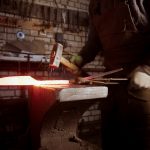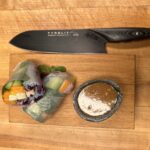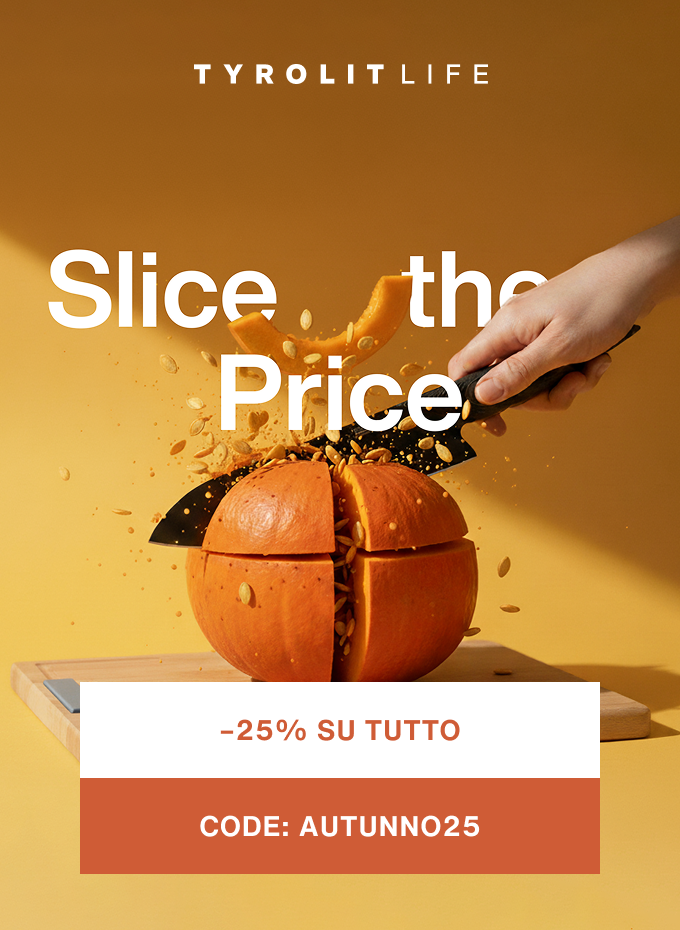Whetstone vs. sharpening machine
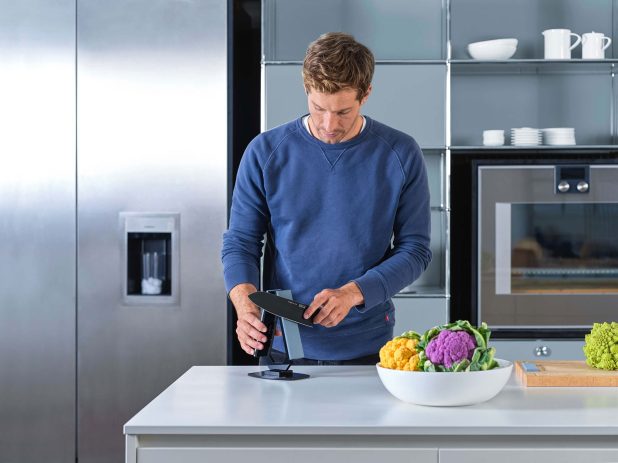
Even for the most experienced chef, choosing between a whetstone or sharpening stone and a sharpening machine remains a central issue when it comes to knife sharpening. The traditional method of the whetstone and the modern technology of the sharpening machine offer different advantages and disadvantages, but are not equally suitable for all applications.
In this article, we will look at the differences between whetstones and grinding machines in detail, and also talk about the innovative knife sharpeners from Tyrol-based abrasive expert Tyrolit.
Sharpening knives – when and why?
Sharpening knives is an essential aspect of kitchen practice to ensure optimal cutting performance and safety. It is advisable to regularly check whether your knives have lost their sharpness. You can recognize a blunt knife, among other things, when food is no longer cut cleanly, but squeezed and torn.
Ideally, sharpening should be part of your kitchen routine. If you find that the knife no longer glides effortlessly through food or you need to apply more pressure, it’s time for a refresher. This improves your cutting results and also increases safety in your kitchen.
You can indeed contribute to keeping your knives sharper for longer. Use a somewhat forgiving surface, like a wooden chopping board, and ensure your knives are stored not just safely but also gently. A magnetic knife block, like the one from Tyrolit, which – just like the cutting board from Tyrolit Life – features an integrated whetstone, is suitable for this purpose.
Knife sharpening methods
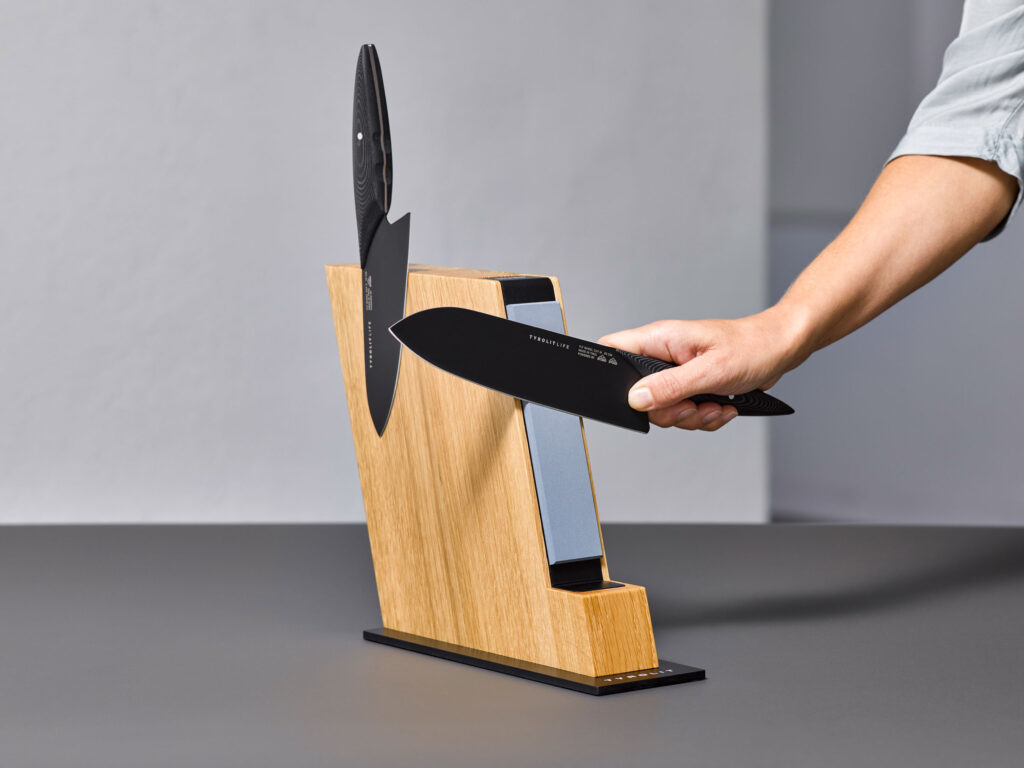
There is far more than one method of knife sharpening. Each of them requires very specific accessories – from classic sharpening stones to manual and electric knife sharpeners.
- Whetstone – Sharpening with a whetstone is a traditional method that requires precision and also some practice. There are different grits for coarse and fine grinding work.
- Sharpening Steel or Honing Steel – A simple tool for home use is the sharpening steel or honing steel. Drawing the blade along the steel quickly sharpens it – ideal for maintaining sharpness between more intensive sharpening sessions.
- Grinding Machine – An electric grinding machine is an efficient tool for sharpening knives. It is suitable for those who prefer a quicker solution. It’s important to pay attention not to overheat the blade or remove too much material.
- Honing Strap – The honing strap is used for fine sharpening following coarse grinding tasks. Leather or fabric straps with a polishing compound ensure a smooth edge.
- Diamond Sharpener – Diamond sharpeners use diamond particles for fast and precise sharpening. They are durable and effective for different types of knives.
- Sharpening Steel – A sharpening steel is a handy tool for quick sharpening. By pulling off along the steel, the blade becomes sharp again. It is well suited to maintaining sharpness on a regular basis.
- Draw-through grinder – A simple, manual draw-through grinder is handy for home use. Pulling the blade through the grinding holes will sharpen it. It is useful for occasional resharpening.
Drawing a distinction between knife sharpeners and manual grinding machines is not straightforward, since these two terms are often used interchangeably. Similarly, sharpening stones and knife sharpeners can be difficult to differentiate: sharpening tools like the Tyrolit Life knife sharpener skillfully blur these boundaries.
Whetstone or grinding machine: the differences
Both whetstones and grinding machines are proven means of maintaining or restoring the sharpness of knives.
Whetstones provide precision through various materials such as natural stones, water stones, or diamond stones. Their application, however, requires skill and some practice—among other things, to achieve the correct sharpening angle. For most European types of knives, this is around 15 degrees, which is why it is already preset in the Tyrolit Life knife sharpener.
Grinding machines, both electric and manual, allow for faster results, but carry the risk of overheating the blade if handled improperly. Care must also be taken not to remove too much material.
Types of sharpening stones
The diversity of materials and types of sharpening stones is vast. A key distinction lies between water stones and oil stones. Water stones require only water as a lubricant and are easier to clean. Oil stones, on the other hand, use oil during the sharpening process and are especially popular in workshops.
Additionally, whetstones vary in the materials used. Natural stones, such as Arkansas stones, provide natural grinding performance. Synthetic materials, including aluminum oxide, silicon carbide, or ceramic, offer precise sharpness and are available in various grit sizes. Combination stones like the ceramic grinding stone from Tyrolit Life also feature different grits (e.g., 400 for coarse grinding and 800 for fine sharpening).
Types of Grinding Machines
There are also countless variants and systems for grinding machines – the most important ones include:
- Sanding belts: Electric belt grinders enable fast and precise sharpening. They are well suited for sharpening coarse edges.
- Grinding wheels: Grinding machines with rotating grinding wheels offer an efficient solution for sharpening different types of knives.
- Grinding stations: These machines offer versatility in the sharpening process and allow working with different grinding belts or discs.
Manual grinding machines such as pull-through grinders, on the other hand, require direct user interaction and offer more control over the grinding process. These are often preferred by users who want more precise handling or are looking for a gentler method for their high-quality knives.
For whom is the whetstone suitable, for whom is the grinding machine suitable?
The whetstone is particularly suited for users who value precision and control over the sharpening process. Artisans and hobby chefs who prefer to sharpen their knives themselves and wish to maintain hands-on control over the process will find the sharpening stone to be an ideal solution. It allows for fine adjustments and is especially suitable for high-quality knives that require gentle treatment.
The grinding machine, on the other hand, is suitable for users seeking efficiency and convenience. It is utilized both in private households and in the catering industry, as well as by professional sharpening services that repair extremely blunt and damaged blades. Professional chefs, catering businesses, or users who need to sharpen a large number of knives regularly benefit from the quick and easy operation of a grinding machine.
To make the whetstone easier to use even for occasional users, Tyrolit Life has developed its own knife sharpener with a preset sharpening angle of 15 degrees. This is ideal for most European knife types, so precision and ease of use are combined in one sharpening tool.
Sharpening with water, oil, or dry
Some sharpening methods require the user to wet sharpen their knives. The choice of sharpening medium—water, oil, or dry—affects both the manual sharpening process with whetstones and the use of grinding machines.
- Sharpening with water: This method is common with water stones. The water acts as a lubricant and facilitates precise sharpening. It reduces wear and simplifies the cleaning of the stones. Additionally, some grinding machines feature a water-cooled option that ensures efficient cooling throughout the grinding process.
- Grinding with oil: Oil stones are used with special grinding oil. The oil promotes uniform abrasion and protects the stone surface from wear. Because oil is less easy to handle compared to water, oil stones are particularly used in workshops.
- Dry grinding: Some grinding stones do not require water or oil. Dry grinding is a clean and convenient method used on certain synthetic grindstones. Dry grinding is widely used in electric grinding machines: grinding wheels or belts often do without additional liquids.
It’s important to follow the manufacturer’s instructions on how to properly use your grinding machine or whetstone.
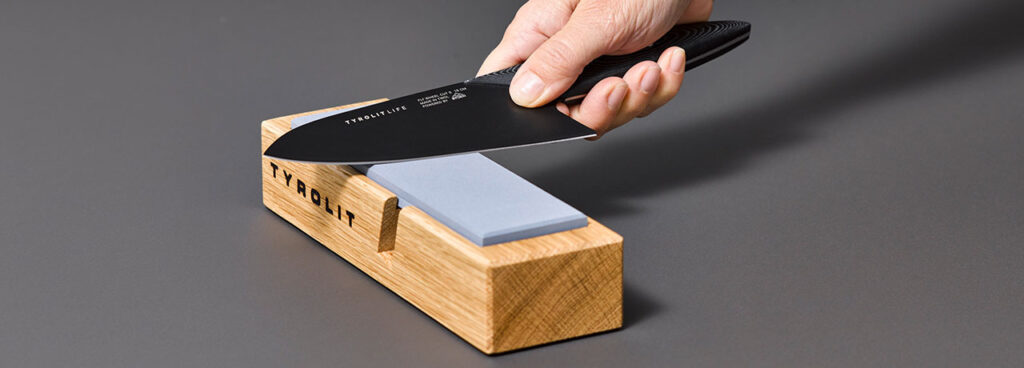
Whetstone vs. grinding machine – advantages and disadvantages at a glance
Both the whetstone and the grinding machine have their valid uses – the classic whetstone is more suited for precise sharpening and requires practice, while grinding machines are more likely to be found in professional settings.
But these are not the only differences. Therefore, here again the advantages and disadvantages of both grinding machines and whetstone at a glance.
| Advantages and disadvantages of whetstones | |
| Benefits | Cons |
| Manual control allows for precise sharpening. | The manual process takes time. |
| Whetstones tend to remove less material from the knife. | Skills and knowledge are required for optimal results. |
| Different whetstones are suitable for different degrees of sharpening. | |
| Advantages and disadvantages of grinding machines | |
| Benefits | Cons |
| Electric grinders are efficient and time-saving. | Often, more material is removed from the blade. |
| Some sanding machines are also suitable for the entry level | High-quality grinding machines can be expensive. |
| The machine can assist in achieving uniform sharpening | Sometimes you can adjust the degree of sharpness less flexibly. |
Reimagining the Sharpening Stone – Knife Sharpening with Tyrolit
Tyrolit is changing the way knives are sharpened by harmonizing the simplicity and efficiency of manual sharpeners with the precision of whetstones.
With a fixed sharpening angle of 15 degrees, the Tyrolit knife sharpener makes sharpening much easier. This angle is considered ideal for most European knife types, but is often not easy to find – and even less easy to hold – especially for beginners.
In addition, Tyrolit also integrates its ceramic grinding stones into cutting boards and knife blocks: the regular grinding and sharpening of high-quality kitchen knives is therefore particularly easy to handle and quickly becomes routine. Blunt knives and crushed food are a thing of the past.
FAQs
What is the use of a whetstone?
Why do you need to wet a sharpening stone?
Which is sharper, 15 or 20 degrees?

